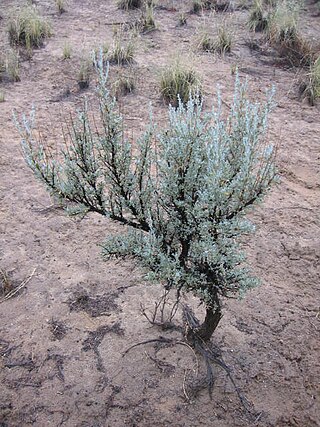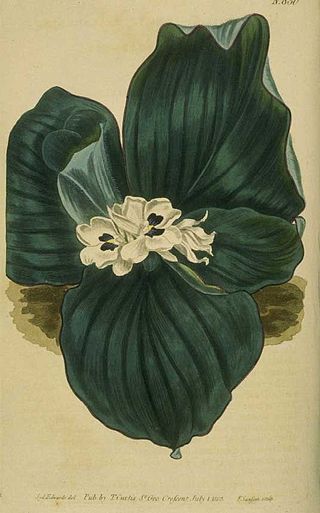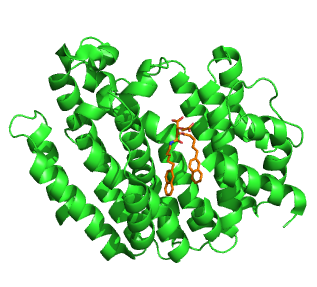
Ginger is a flowering plant whose rhizome, ginger root or ginger, is widely used as a spice and a folk medicine. It is a herbaceous perennial which grows annual pseudostems about one meter tall bearing narrow leaf blades. The inflorescences bear flowers having pale yellow petals with purple edges, and arise directly from the rhizome on separate shoots.

Terpenes are a class of natural products consisting of compounds with the formula (C5H8)n for n > 1. Comprising more than 30,000 compounds, these unsaturated hydrocarbons are produced predominantly by plants, particularly conifers. Terpenes are further classified by the number of carbons: monoterpenes (C10), sesquiterpenes (C15), diterpenes (C20), as examples. The terpene alpha-pinene, is a major component of the common solvent, turpentine.

Bilobalide is a biologically active terpenic trilactone present in Ginkgo biloba.
Farnesyl pyrophosphate (FPP), also known as farnesyl diphosphate (FDP), is an intermediate in the biosynthesis of terpenes and terpenoids such as sterols and carotenoids. It is also used in the synthesis of CoQ, as well as dehydrodolichol diphosphate.

β-sitosterol (beta-sitosterol) is one of several phytosterols with chemical structures similar to that of cholesterol. It is a white, waxy powder with a characteristic odor, and is one of the components of the food additive E499. Phytosterols are hydrophobic and soluble in alcohols.

Sesquiterpenes are a class of terpenes that consist of three isoprene units and often have the molecular formula C15H24. Like monoterpenes, sesquiterpenes may be cyclic or contain rings, including many unique combinations. Biochemical modifications such as oxidation or rearrangement produce the related sesquiterpenoids.

Kaempferia galanga, commonly known as kencur, aromatic ginger, sand ginger, cutcherry, is a monocotyledonous plant in the ginger family, and one of four plants called galangal. It is found primarily in open areas in Indonesia, southern China, Taiwan, Cambodia, and India, but is also widely cultivated throughout Southeast Asia.

Squalene synthase (SQS) or farnesyl-diphosphate:farnesyl-diphosphate farnesyl transferase is an enzyme localized to the membrane of the endoplasmic reticulum. SQS participates in the isoprenoid biosynthetic pathway, catalyzing a two-step reaction in which two identical molecules of farnesyl pyrophosphate (FPP) are converted into squalene, with the consumption of NADPH. Catalysis by SQS is the first committed step in sterol synthesis, since the squalene produced is converted exclusively into various sterols, such as cholesterol, via a complex, multi-step pathway. SQS belongs to squalene/phytoene synthase family of proteins.

Shogaols are pungent constituents of ginger similar in chemical structure to gingerol. The most common of the group is [6]-shogaol. Like zingerone, it is produced when ginger is dried or cooked. Moreover, shogaol are converted to other constituents when heat is applied over time, which is why ginger loses its spiciness as it is cooked.

Carotol was first isolated by scientists Asahina and Tsukamoto in 1925. It is one of the primary components found in carrot seed oil comprising approximately 40% of this essential oil. This sesquiterpene alcohol is thought to be formed in carrot seeds during the vegetation period. Additionally, studies have shown that carotol may be involved in allelopathic interactions expressing activity as an antifungal, herbicidal and insecticidal agent.

Capsidiol is a terpenoid compound that accumulates in tobacco Nicotiana tabacum and chili pepper Capsicum annuum in response to fungal infection. Capsidiol is categorized under the broad term of phytoalexin, a class of low molecular weight plant secondary metabolites that are produced during infection. Phytoalexins are also characterized as a part of a two pronged response to infection which involves a short term response consisting of production of free radicals near the site of infection and a long term response involving the production of hormones and an increase in enzymes to biosynthesize phyoalexins such as capsidiol.

Juvabione, historically known as the paper factor, is the methyl ester of todomatuic acid, both of which are sesquiterpenes (C15) found in the wood of true firs of the genus Abies. They occur naturally as part of a mixture of sesquiterpenes based upon the bisabolane scaffold. Sesquiterpenes of this family are known as insect juvenile hormone analogues (IJHA) because of their ability to mimic juvenile activity in order to stifle insect reproduction and growth. These compounds play important roles in conifers as the second line of defense against insect induced trauma and fungal pathogens.

(+)-Costunolide is a naturally occurring sesquiterpene lactone, first isolated in Saussurea costus roots in 1960. It is also found in lettuce.
(2Z,6Z)-farnesyl diphosphate synthase is an enzyme with systematic name dimethylallyl-diphosphate:isopentenyl-diphosphate cistransferase . This enzyme catalyses the following chemical reaction

Thujopsene is a natural chemical compound, classified as a sesquiterpene, with the molecular formula C15H24.
β-Eudesmol synthase (EC 4.2.3.68) is an enzyme with systematic name (2E,6E)-farnesyl-diphosphate diphosphate-lyase (β-eudesmol-forming). This enzyme catalyses the following chemical reaction
α-Eudesmol synthase (EC 4.2.3.85) is an enzyme with systematic name (2E,6E)-farnesyl-diphosphate diphosphate-lyase (α-eudesmol-forming). This enzyme catalyses the following chemical reaction

Arglabin is a sesquiterpene lactone belonging to the guaianolide subclass bearing a 5,7,5-tricyclic ring system which is known to inhibit farnesyl transferase. It is characterized by an epoxide on the cycloheptane as well as an exocyclic methylene group that is conjugated with the carbonyl of the lactone. Arglabin is extracted from Artemisia glabella, a species of wormwood, found in the Karaganda Region of Kazakhstan. Arglabin and its derivatives are biologically active and demonstrate promising antitumor activity and cytoxocity against varying tumor cell lines.

Avarol is a hydroquinone first isolated from the Mediterranean marine sponge Dysidea avara 1974 Avarol represented the first sesquiterpenoid with a rearranged drimane skeleton and its structure was established by standard analytical methods, chemical degradation and later by stereocontrolled synthesis. Intrigued by the wide range of biological activities of this metabolite, Avarol has inspired the development of many synthetic derivatives and the study of their applications.

Drimentine G belongs to the family of drimentine, or more commonly known as terpenylated diketopiperazine. As the name suggests, DMT G contains two different parts, one comes from the non-ribosomal peptide synthetase (NRPS) pathway to generate the diketopiperazine ring structure. The other part comes from either the mevalonic acid pathway (MVA) or deoxy xylulose phosphate pathway (MEP) to produce sesquiterpene needed for interaction with the diketopiperazine. This molecule is said to be useful as an antibiotic to treat bacterial or fungi infections, has therapeutic application to treat animal health, and can serve as a pest control for plants.

















